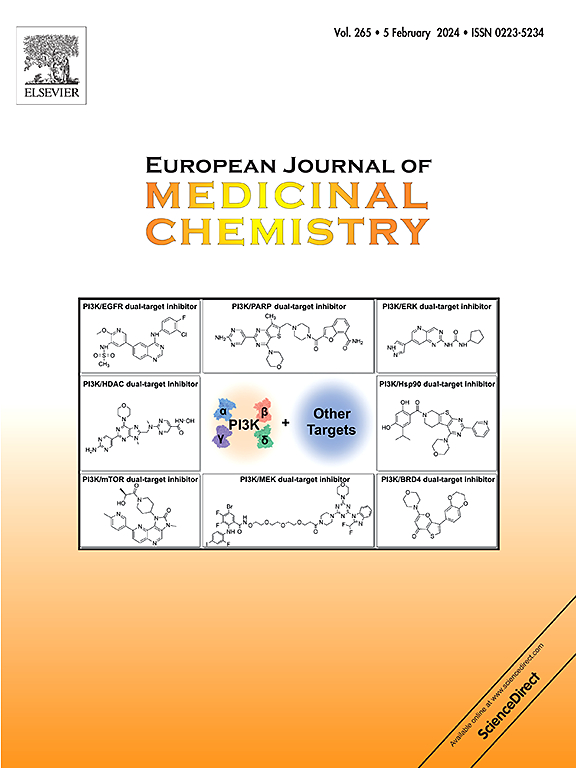Novel water-soluble and highly efficient dual type I/II next generation inhibitors of FMS-like tyrosine kinase 3 (FLT3)
IF 6
2区 医学
Q1 CHEMISTRY, MEDICINAL
引用次数: 0
Abstract
Mutations of the FMS-like tyrosine kinase (FLT3) occur in acute myeloid leukemia (AML) and are associated with very poor prognosis. Available FLT3 inhibitors are potent but either show a lack of selectivity regarding other tyrosine kinases or only transient efficacy due to emerging resistance under therapy. Water-soluble derivatives of the tyrosine kinase inhibitor Marbotinib are highly selective dual-type I/II inhibitors of FLT3.
The bisarylmethanone-based compound 29 and its carbamate derivative 42 show excellent results in various biological tests. They inhibit FLT3-ITD (internal tandem duplication) as well as therapy-associated FLT3-TKD point mutations. Additionally, good water solubility and consequently biological availability was achieved by attaching amine functions to appropriate scaffold positions, suggested by modeling of inhibitor binding at inactive and active FLT3 states. Subsequent formation of different salts led to very promising results in in vivo studies and improvements compared to midostaurin (1b), Quizartinib (7), Marbotinib 10 and its carbamate 11c.

新型水溶性高效双I/II型新一代fms样酪氨酸激酶3 (FLT3)抑制剂
fms样酪氨酸激酶(FLT3)突变发生在急性髓性白血病(AML)中,并与非常差的预后相关。现有的FLT3抑制剂是有效的,但要么对其他酪氨酸激酶缺乏选择性,要么由于治疗中出现的耐药性而只有短暂的疗效。酪氨酸激酶抑制剂Marbotinib的水溶性衍生物是FLT3的高选择性双型I/II抑制剂。以双芳基甲烷为基础的化合物29及其氨基甲酸酯衍生物42在各种生物学试验中表现出优异的效果。它们抑制FLT3-ITD(内部串联复制)以及治疗相关的FLT3-TKD点突变。此外,通过模拟抑制剂在FLT3非活性和活性状态下的结合,可以将胺功能附着在适当的支架位置,从而实现良好的水溶性和生物利用度。随后形成的不同盐类在体内研究中获得了非常有希望的结果,并且与米多舒汀(1b)、Quizartinib(7)、Marbotinib 10及其氨基甲酸酯11c相比有所改进。
本文章由计算机程序翻译,如有差异,请以英文原文为准。
求助全文
约1分钟内获得全文
求助全文
来源期刊
CiteScore
11.70
自引率
9.00%
发文量
863
审稿时长
29 days
期刊介绍:
The European Journal of Medicinal Chemistry is a global journal that publishes studies on all aspects of medicinal chemistry. It provides a medium for publication of original papers and also welcomes critical review papers.
A typical paper would report on the organic synthesis, characterization and pharmacological evaluation of compounds. Other topics of interest are drug design, QSAR, molecular modeling, drug-receptor interactions, molecular aspects of drug metabolism, prodrug synthesis and drug targeting. The journal expects manuscripts to present the rational for a study, provide insight into the design of compounds or understanding of mechanism, or clarify the targets.

 求助内容:
求助内容: 应助结果提醒方式:
应助结果提醒方式:


